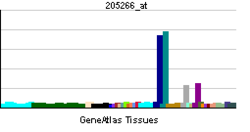Inhibitorni faktor leukemije
| edit |
Inhibitorni faktor leukemije, ili LIF, je citokin iz interleukin 6 klase. Ovaj protein utiče na ćelijski rast i razvoj.
Funkcija uredi
LIF citokin je dobio ime po njegovoj sposobnosti da indukuje terminalnu diferencijaciju ćelija mijeloidne leukemije. Druge osobine ovog citokina su: promocija rasta i ćelijske diferencijacije različitih tipova ciljnih ćelija, uticaj na koštani metabolizam, kaheksiju, neuronski razvoj, embriogenezu i inflamacija. Za p53 regulisani LIF je bilo pokazano da omogućava implantaciju u mišjem modelu.[1][2]
Vezivanje/aktivacija uredi
LIF se vezuje za specifični LIF receptor (LIFR-α) koji formira heterodimer sa specifičnom podjedinicom zajedničkom za sve članove te familije receptora, GP130 podjedinicom signalne transdukcije. Ovo dovodi do aktivacije JAK/STAT (Janus kinaza/signal transducer i aktivator transkripcije) i MAPK (mitogenom aktivirana proteinska kinaza) kaskade.
Ekspresija uredi
LIF je normalno izražen u trofektodermu embriona u razvoju. Njegov receptor LIFR je izražen širom unutrašnje ćelijske mase. Pošto su embrionske stem ćelije izvedene iz unutrašnje ćelijske mase u stupnju blastocista, njihovo uklanjanje iz unutrašnje ćelijske mase takođe uklanja njihov LIF izvor.
Upotreba u stem ćelijskim kulturama uredi
LIF odstranjivanje potiskuje stem ćelije ka diferencijaciji, ali one zadržavaju svoj proliferativni potencijal ili pluripotentnost. Iz tog razloga LIF se koristi u mišjim embrionskim stem ćelijskim kulturama. On je neophodan za održavanje stem ćelija u nediferenciranom stanju. Moguće je genetskim manipulacijom embrionskih stem ćelija omogućiti LIF nezavisni razvoj, posebno prekomernim izražavanjem gena Nanog.
LIF nije neophodan za kulture ljudskih embrionskih stem ćelija.[3] [4]
Reference uredi
- ↑ Wenwei Hu, Zhaohui Feng, Angelika K. Teresky1, Arnold J. Levine (November 29, 2007). „p53 regulates maternal reproduction through LIF”. Nature 450: 721-724.
- ↑ Mire-Sluis, Anthony R.; Thorpe, Robin, ur. (1998). Cytokines (Handbook of Immunopharmacology). Boston: Academic Press. ISBN 0-12-498340-5.
- ↑ Kawahara Y, Manabe T, Matsumoto M, Kajiume T, Matsumoto M, Yuge L (2009). „LIF-free embryonic stem cell culture in simulated microgravity”. PLoS ONE 4 (7): e6343. DOI:10.1371/journal.pone.0006343. PMC 2710515. PMID 19626124.
- ↑ „CGS : PTO Finds Stem Cell Patent Anticipated, Obvious in Light of 'Significant Guideposts'”.
Literatura uredi
- Patterson PH (1994). „Leukemia inhibitory factor, a cytokine at the interface between neurobiology and immunology.”. Proc. Natl. Acad. Sci. U.S.A. 91 (17): 7833–5. DOI:10.1073/pnas.91.17.7833. PMC 44497. PMID 8058719.
- Aghajanova L (2005). „Leukemia inhibitory factor and human embryo implantation.”. Ann. N. Y. Acad. Sci. 1034: 176–83. DOI:10.1196/annals.1335.020. PMID 15731310.
- Králícková M, Síma P, Rokyta Z (2005). „Role of the leukemia-inhibitory factor gene mutations in infertile women: the embryo-endometrial cytokine cross talk during implantation--a delicate homeostatic equilibrium.”. Folia Microbiol. (Praha) 50 (3): 179–86. DOI:10.1007/BF02931563. PMID 16295654.
- Stahl J, Gearing DP, Willson TA, et al. (1990). „Structural organization of the genes for murine and human leukemia inhibitory factor. Evolutionary conservation of coding and non-coding regions.”. J. Biol. Chem. 265 (15): 8833–41. PMID 1692837.
- Bazan JF (1991). „Neuropoietic cytokines in the hematopoietic fold.”. Neuron 7 (2): 197–208. DOI:10.1016/0896-6273(91)90258-2. PMID 1714745.
- Lowe DG, Nunes W, Bombara M, et al. (1989). „Genomic cloning and heterologous expression of human differentiation-stimulating factor.”. DNA 8 (5): 351–9. PMID 2475312.
- Sutherland GR, Baker E, Hyland VJ, et al. (1989). „The gene for human leukemia inhibitory factor (LIF) maps to 22q12.”. Leukemia 3 (1): 9–13. PMID 2491897.
- Mori M, Yamaguchi K, Abe K (1989). „Purification of a lipoprotein lipase-inhibiting protein produced by a melanoma cell line associated with cancer cachexia.”. Biochem. Biophys. Res. Commun. 160 (3): 1085–92. DOI:10.1016/S0006-291X(89)80114-7. PMID 2730639.
- Gough NM, Gearing DP, King JA, et al. (1988). „Molecular cloning and expression of the human homologue of the murine gene encoding myeloid leukemia-inhibitory factor.”. Proc. Natl. Acad. Sci. U.S.A. 85 (8): 2623–7. DOI:10.1073/pnas.85.8.2623. PMC 280050. PMID 3128791.
- Williams RL, Hilton DJ, Pease S, et al. (1989). „Myeloid leukaemia inhibitory factor maintains the developmental potential of embryonic stem cells.”. Nature 336 (6200): 684–7. DOI:10.1038/336684a0. PMID 3143916.
- Moreau JF, Donaldson DD, Bennett F, et al. (1989). „Leukaemia inhibitory factor is identical to the myeloid growth factor human interleukin for DA cells.”. Nature 336 (6200): 690–2. DOI:10.1038/336690a0. PMID 3143918.
- Yamaguchi M, Miki N, Ono M, et al. (1995). „Inhibition of growth hormone-releasing factor production in mouse placenta by cytokines using gp130 as a signal transducer.”. Endocrinology 136 (3): 1072–8. DOI:10.1210/en.136.3.1072. PMID 7867561.
- Schmelzer CH, Harris RJ, Butler D, et al. (1993). „Glycosylation pattern and disulfide assignments of recombinant human differentiation-stimulating factor.”. Arch. Biochem. Biophys. 302 (2): 484–9. DOI:10.1006/abbi.1993.1243. PMID 8489250.
- Aikawa J, Ikeda-Naiki S, Ohgane J, et al. (1997). „Molecular cloning of rat leukemia inhibitory factor receptor alpha-chain gene and its expression during pregnancy.”. Biochim. Biophys. Acta 1353 (3): 266–76. PMID 9349722.
- Hinds MG, Maurer T, Zhang JG, et al. (1998). „Solution structure of leukemia inhibitory factor.”. J. Biol. Chem. 273 (22): 13738–45. DOI:10.1074/jbc.273.22.13738. PMID 9593715.
- „Toward a complete human genome sequence.”. Genome Res. 8 (11): 1097–108. 1999. PMID 9847074.
- Tanaka M, Hara T, Copeland NG, et al. (1999). „Reconstitution of the functional mouse oncostatin M (OSM) receptor: molecular cloning of the mouse OSM receptor beta subunit.”. Blood 93 (3): 804–15. PMID 9920829.
- Nakashima K, Yanagisawa M, Arakawa H, et al. (1999). „Synergistic signaling in fetal brain by STAT3-Smad1 complex bridged by p300.”. Science 284 (5413): 479–82. DOI:10.1126/science.284.5413.479. PMID 10205054.
- Dunham I, Shimizu N, Roe BA, et al. (1999). „The DNA sequence of human chromosome 22.”. Nature 402 (6761): 489–95. DOI:10.1038/990031. PMID 10591208.

